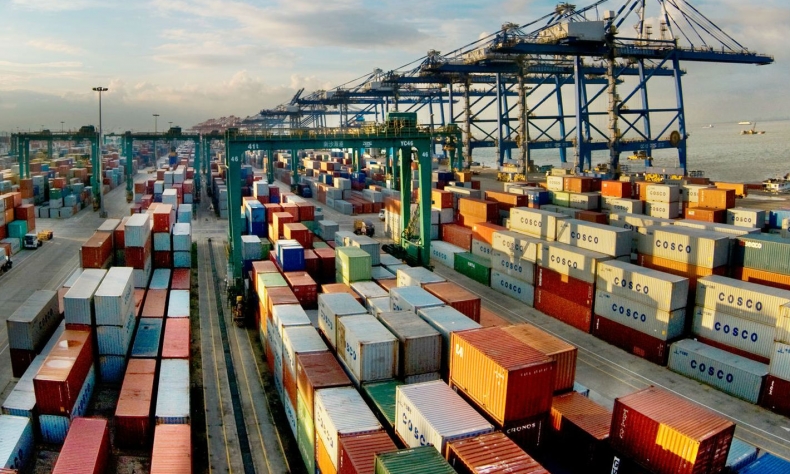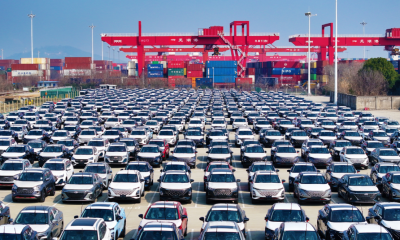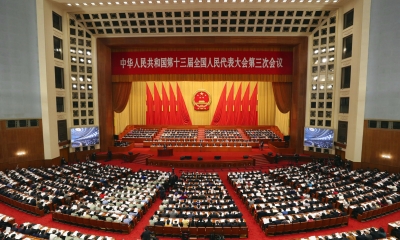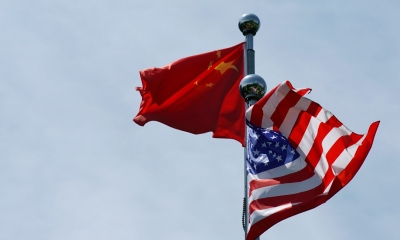China Is Fast Rising as the World Largest Economic Powerhouse

The past 5 years has witnessed the historical rise of Chinese economy as the largest powerhouse driving the world economy forward. The Chinese economy entered the New Normal in 2012. Although there has been no longer two-digit growth, it has still experienced a medium-high growth rate with a better, cleaner and higher-end technology quality.
The past 5 years since the 18th CPC National Congress in November 2012 has witnessed the historical rise of Chinese economy as the largest powerhouse driving the world economy forward.
The Chinese economy entered the New Normal in 2012. Although there has been no longer two-digit growth, it has still experienced a medium-high growth rate with a better, cleaner and higher-end technology quality.
Fast GDP Growth
The Chinese GDP hit ¥74,412.7 billion ( $ 11,199.1 billion) in 2016, an accumulative nominal growth of 30.8% over the ¥ 54,036.7 billion ($8,560.5 billion) in 2012. The past five years saw the real growth rates at 7.9%, 7.8%, 7.3%, 6.9%and 6.7% respectively, by far the fastest rates among world leading economies. During this period, China’s share in total world GDP rose from 11.4% in 2012 to 14.8% in 2016. While the world nominal GDP only increased by less than $ 1 trillion ($ 74.802 in 2012 and $ 75.544 in 2016), China’s GDP increased by $ 2.64 trillion, or three times larger than the world total growth. In terms of real growth, China contributed over 30% of total world growth, larger than the US, EU and Japan combined. China overtook Japan as the world second largest economy in 2010. Six years later, it was more than twice the size of Japan, and larger than Germany, UK and France combined. China is also fast closing its distance to the US, the world largest economy. According to the World Bank data, in 2012, total GDP of China was 53.0% of that of the US at $ 16,163.2 billion. In 2016, it was 60.0% of the latter ($ 18561.9 billion).
China overtook Japan as the world second largest economy in 2010. Six years later, it was more than twice the size of Japan, and larger than Germany, UK and France combined. China is also fast closing its distance to the US, the world largest economy. According to the World Bank data, in 2012, total GDP of China was 53.0% of that of the US at $ 16,163.2 billion. In 2016, it was 60.0% of the latter ($ 18561.9 billion). Also according to the World Bank, China’s per capita GDP increased from $ 6,337.88 in 2012 to $ 8,123.18 in 2016, up 28.2%. Its per capita GDP was only 60.1% of the world average ($ 10,539.39) in 2012, but was 80.0% of the world average ($ 10,150.79) in 2016. If the Chinese economy keeps growing at 6.5% during 2017-2020 and 6.0% for 2021-2025, its per capita GDP will exceed $ 13,000 by 2024 and thus become a high income economy.
Also according to the World Bank, China’s per capita GDP increased from $ 6,337.88 in 2012 to $ 8,123.18 in 2016, up 28.2%. Its per capita GDP was only 60.1% of the world average ($ 10,539.39) in 2012, but was 80.0% of the world average ($ 10,150.79) in 2016. If the Chinese economy keeps growing at 6.5% during 2017-2020 and 6.0% for 2021-2025, its per capita GDP will exceed $ 13,000 by 2024 and thus become a high income economy.
The disposal income of the Chinese urban and rural people has been growing faster than per capita GDP. The per capita disposal income of the Chinese residents grew from ¥16,510 in 2012 to ¥23,821 in 2016 ,up 44.3%. That of the urban residents increased from ¥24,565 to ¥33,616, up 36.8%, and that of the rural residents from ¥7,919 to¥12363, up 56.2%.
The World Largest Industrial and High Speed Railway Power
China outstripped the US as the world largest manufacturing power in 2012 and has been expanding the leading edge since then. In 2016, China’s total industrial added value reached ¥24.79 trillion ($ 3.81 trillion), 18.6% up over 2012. The overwhelming superiority in vast numbers of industrial output or capacities is just astonishing. In 2016 China’s output of steel products reached 1.14 billion tons, more than 50% of the world total. It also produced 28.12 million units of automotives, larger than that of the US and Japan combined. China produced 2.06 billion mobile phone sets (out of the total, 1.54 billion sets are intelligent phones), more than the rest of the world produced. China is moving energetically from a manufacturing giant to the high-end manufacturing power, under the master plans of Made in China 2025 and of AI development. The Quantum satellite, Tiangong space lab, and trunk line commercial aircraft C919 are just a few examples. China had a total power generating capacity of 1,645.75 Giga watts. The newly installed capacity each year was larger than the accumulative capacity of UK. China is also moving fast in alternative energy development, with the nuclear, wind and solar power capacity combined at 159.70 Giga watts, 15.8% of the total.
China had a total power generating capacity of 1,645.75 Giga watts. The newly installed capacity each year was larger than the accumulative capacity of UK. China is also moving fast in alternative energy development, with the nuclear, wind and solar power capacity combined at 159.70 Giga watts, 15.8% of the total.
What surprises the world most is the speed of high speed railway (HSR) build-up. Just in 8 years, the total length of HSR in China increased from zero to 22,000 kilometers, or over 60% of the world total, and is still expanding at 2,500 kilometers per year.
World Largest Trading Nation and Second Largest Outbound Investor
Different from the performances of the GDP and industrial production where the growth was uninterrupted, China’s trade experienced ups and downs over the past 5 years. China total trade volume overtook the US as the world largest trading nation in 2013, and continued a 6.1% growth in 2014 to $ 4.3 trillion. In 2015-2016, it decreased by an accumulative 14.4%, affected by the poor world market environment, the rising cost, and RMB’s fall to the dollar. Since the start of this year, a strong rebound has appeared with the first 8 months registered 11.6% increase, thus recouped all the losses during the previous two years. China will remain the world top trading nation in 2017. While the inbound foreign investment has been stable over past four years, the outbound investment surged. In 2016, China total FDI inflows hit $ 126.0 billion, 12.8% over 2012 at $ 111.7 billion. Its outbound investment (ODI) hit $ 170.1 billion, 2.2 times that in 2012 ($ 77.2 billion). China’s ODI overtook its FDI for the first time in history in 2014, and thus becoming a net capital exporter. According to the < World Investment Report 2017> released by UNCTAD, China’s ODI flow in 2012 was $ 87.8 billion, roughly over one fourth that of the US ($ 318.2 billion), two thirds that of Japan ($ 122.5 billion) and slightly smaller than Luxemburg ($ 89.8 billion). In 2016, however, China’s ODI increased to $ 183.1 billion, the world second largest, and roughly 60% of the US ($ 299.0 billion).
While the inbound foreign investment has been stable over past four years, the outbound investment surged. In 2016, China total FDI inflows hit $ 126.0 billion, 12.8% over 2012 at $ 111.7 billion. Its outbound investment (ODI) hit $ 170.1 billion, 2.2 times that in 2012 ($ 77.2 billion). China’s ODI overtook its FDI for the first time in history in 2014, and thus becoming a net capital exporter. According to the < World Investment Report 2017> released by UNCTAD, China’s ODI flow in 2012 was $ 87.8 billion, roughly over one fourth that of the US ($ 318.2 billion), two thirds that of Japan ($ 122.5 billion) and slightly smaller than Luxemburg ($ 89.8 billion). In 2016, however, China’s ODI increased to $ 183.1 billion, the world second largest, and roughly 60% of the US ($ 299.0 billion).
The One Belt, One Road Initiative and China’s firm commitment to supporting globalization, has moved China quickly to the center of world trade and investment stage, and is changing the world economic landscape.
The 19th CPC National Congress will be convened on October 18, 2017. New blueprints for the next five years growth will be mapped out. The next five years will cross the timeline of the first centenary (2021) and bring the overall well-being society to reality.
According to IMF latest estimate in its <World Economic Outlook>, the world GDP will grow by 3.5% in 2017 and 3.6% in 2018, and likely by 3.8% in 2022. The Chinese economy already accounts for 14.8% of the world total. The 6.5% growth in Chinese GDP will continue 0.96 pct to the world growth, or 25.3% of the total. With its share rising in world GDP, China’s contribution to world growth will likely to grow as well. As the world second largest economy, China will continue to serve as an indispensable powerhouse to the balanced, sustainable and strong growth of the world economy as a whole.
 Facebook
Facebook
 Twitter
Twitter
 Linkedin
Linkedin
 Google +
Google +








Just another article about the “great china”, but admit it, China is stronger than ever.
Um..it seems that China no longer just chase the speed economic growth.
Um..it seems that China no longer just chase the speed economic growth.
“China produced 2.06 billion mobile phone sets (out of the total, 1.54 billion sets are intelligent phones), more than the rest of the world produced.” Omg..that’s really huge.
I am willing to buy products made in China, that’s leave people less to worry about
I dont know about the others, but the train in china is really safe and fast
I am using a china cellphone named huawei, it’s much smoothy than iphone. in fact, a lot of china product is really nice.
It’s like a mircale for so many solid numbers